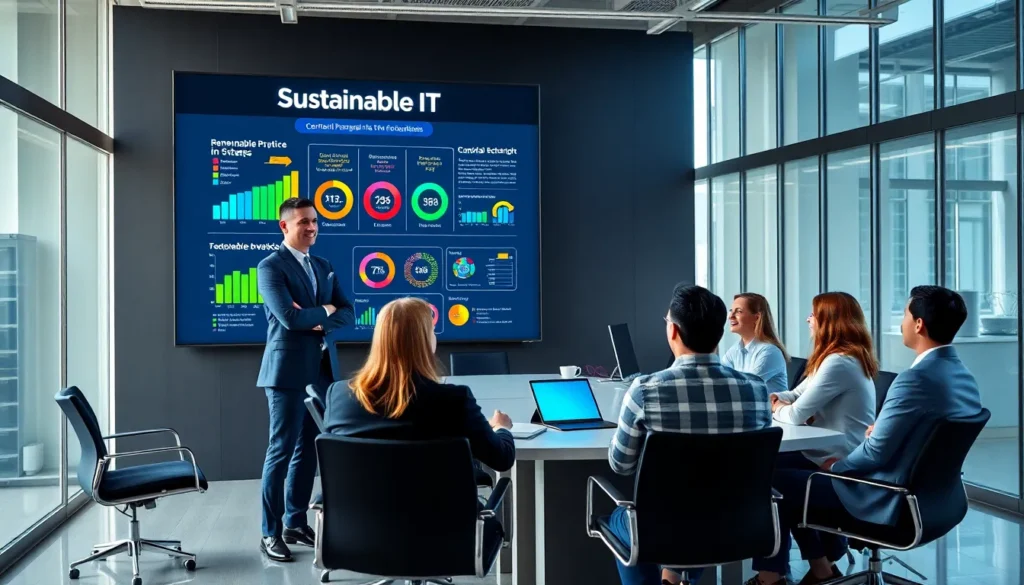Table of Contents
ToggleIn an era where technology drives innovation faster than you can say ‘disruption,’ sustainability is the unsung hero all tech leaders need to embrace. Imagine running a tech empire while also saving the planet. Picture your company’s IT department, not as the energy hog of yesteryears, but as a beacon of hope lighting the path toward sustainability. This might sound like the stuff of fairy tales, but with the right strategies, it’s entirely achievable. Grab your digital broomsticks, because this playbook will guide you through the magical realm of Sustainable IT with a sprinkle of humor and a wealth of expertise.
Understanding Sustainable IT

Sustainable IT isn’t just a buzzword: it’s a game-changer for technology leaders. At its core, it means utilizing technology in a way that’s environmentally, economically, and socially responsible. It’s about balancing business needs with the planet’s health. After all, nobody wants to be the villain in their own story, right?
Consider the implications, every byte of data stored, every device powered, and every hour of cloud computing comes with a carbon footprint. Recognizing this allows organizations to make informed decisions that benefit both business and the earth. Hence, understanding sustainable IT begins with awareness, knowing how technology impacts the environment and the importance of integrating sustainability into every IT strategy.
Key Principles of Sustainable IT
To build a robust sustainable IT framework, several key principles emerge. These aren’t mere guidelines: they act as the compass guiding every tech leader in the right direction.
- Energy Efficiency: The first principle revolves around minimizing energy consumption. From optimizing server use to leveraging energy-efficient hardware, every electron saved is a step towards sustainability.
- Lifecycle Management: This principle emphasizes responsible management of hardware through its entire lifecycle, from acquisition to disposal. Think of it as a good relationship: you want to nurture it, not just discard it when things get tough.
- Supply Chain Sustainability: Partner with vendors who share a commitment to sustainability. This alignment creates a ripple effect, turning your supply chain into a sustainable ecosystem.
- Digitalization: Use technology to reduce physical resources, think paperless offices and virtual meetings. By going digital, leaders can save trees while simultaneously streamlining operations.
- Circular Economy: Aim to recycle and repurpose IT assets rather than tossing them into landfills. This principle shifts the focus from a linear to a circular economy, enhancing sustainability across the board.
Strategies for Implementing Sustainable IT Practices
So how can technology leaders bring these principles to life? Here are some effective strategies:
- Conduct an IT Sustainability Assessment: Start with an audit of current practices. What’s working? What isn’t? Identifying gaps sets the stage for effective change.
- Invest in Green Technologies: Cloud computing, virtualization, and energy-efficient data centers can significantly reduce energy consumption. Embracing these technologies will not only enhance performance but also bolster sustainability.
- Employee Engagement Programs: Involve staff in sustainability initiatives. Whether it’s hosting workshops or creating green teams, engaging employees fosters a culture committed to sustainability.
- Encourage Remote Work: The pandemic taught us that many jobs can be performed from anywhere. Remote work reduces commuting emissions while maintaining productivity. Plus, who doesn’t love working in slippers?
- Carry out Monitoring Tools: Use tools to track energy consumption and waste. Visibility leads to accountability, and data often tells a compelling story.
Measuring and Reporting Sustainability in IT
Once sustainable practices are in place, the next step is measurement. How can tech leaders assess their sustainability efforts? Here are some approaches:
- Sustainability KPIs: Define key performance indicators to measure progress. Metrics such as energy use per user or carbon footprint reduction are essential for tracking improvements.
- Regular Reporting: Develop a reporting schedule to hold the organization accountable. Transparency in sustainability efforts enhances credibility and demonstrates commitment to both stakeholders and customers.
- Third-Party Audits: Consider engaging external auditors for an impartial review. These assessments can reveal insights and areas for improvement that internal teams might overlook.
Challenges and Solutions in Sustainable IT Adoption
Every journey has its bumps, doesn’t it? Technology leaders face various challenges when implementing sustainable IT, but these obstacles aren’t insurmountable.
- Resistance to Change: Many employees resist shifting habits. Combat this by promoting the benefits and involving everyone in the transition process.
- Budget Constraints: Sustainable technologies can sometimes appear costly. But, focus on the long-term savings and ROI. Energy savings can lead to substantial reductions in operational costs over time.
- Lack of Knowledge: If the skills aren’t there, upskilling is essential. Provide training and resources to empower teams to adopt sustainable practices confidently.
Future Trends in Sustainable IT
The landscape of sustainable IT is ever-evolving. Several emerging trends hint at where the future is headed:
- Artificial Intelligence (AI): AI technologies can optimize resource use, predict maintenance needs, and even automate processes to reduce waste.
- Blockchain for Sustainable Supply Chains: This technology can improve transparency and traceability in supply chains, providing insights into sustainability practices.
- Edge Computing: By reducing the distance data needs to travel, edge computing can minimize latency and energy consumption. This trend is set to boost efficiency while adhering to sustainable practices.
- Sustainable Data Centers: Future data centers will aim for carbon neutrality, employing renewable energy sources and advanced cooling technologies to enhance sustainability.




